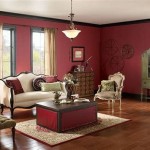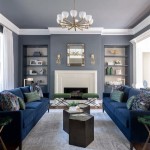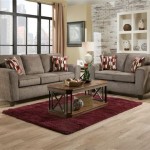How to Decorate a Grey Living Room
Grey has become a staple in interior design, offering a versatile and sophisticated backdrop for a living room. Its neutrality allows for a wide range of complementary colors, textures, and styles, making it a popular choice for homeowners seeking both contemporary and classic aesthetics. However, the key to a successfully decorated grey living room lies in understanding how to leverage its inherent qualities to create a space that is both inviting and visually appealing.
This article provides a comprehensive guide to decorating a grey living room, covering essential aspects from choosing the right shade of grey to incorporating accent colors, furniture styles, and finishing touches.
Selecting the Right Shade of Grey
The initial step in decorating a grey living room involves selecting the appropriate shade of grey for the walls. Grey is not a monolithic color; it exists along a spectrum ranging from almost white to nearly black, and each shade possesses unique characteristics that influence the overall mood and feel of the room. A light grey can create a spacious and airy atmosphere, while a darker grey can evoke a sense of warmth and intimacy.
Consider the following factors when choosing a shade of grey:
Room Size and Lighting: In smaller rooms or rooms with limited natural light, opt for lighter shades of grey to maximize brightness and create an illusion of spaciousness. Darker shades can make a small room feel cramped. Conversely, in larger rooms with ample natural light, darker shades of grey can be used to create a more dramatic and cozy ambiance.
Undertones: Grey has undertones of other colors, such as blue, green, purple, or beige. These undertones can significantly impact how the grey appears in different lighting conditions and when paired with other colors. Cool greys with blue or green undertones tend to create a modern and serene aesthetic, while warm greys with beige or brown undertones can evoke a more traditional and inviting atmosphere. To identify the undertone, compare paint swatches of different greys side-by-side under natural and artificial light.
Personal Preference: Ultimately, the best shade of grey is one that resonates with personal taste and complements the desired style. Experiment with paint samples on the walls to observe how the color changes throughout the day under varying lighting conditions. Take into consideration existing furniture and accessories, as the grey should harmonize with the overall color scheme.
Once the wall color is determined, consider the effect of different grey tones on other elements within the space. For instance, a lighter grey sofa paired with darker grey walls offers contrast and prevents the room from feeling washed out. Conversely, a dark grey sofa can ground a room with lighter grey walls.
Incorporating Complementary Colors
While grey serves as a neutral foundation, the addition of complementary colors is crucial for creating visual interest and personality. An effective color palette transforms a grey living room from bland to vibrant. The choice of accent colors depends on the desired mood and style, as well as the specific shade of grey used.
Here are some color pairings that work well with grey:
Yellow: Yellow provides a cheerful and energetic contrast to grey, adding warmth and brightness. Muted yellows, such as ochre or mustard, create a sophisticated and earthy feel, while brighter yellows offer a more playful and contemporary look. Yellow can be incorporated through cushions, throws, artwork, or even a statement chair.
Blue: Blue, particularly shades of navy, teal, or powder blue, complements grey beautifully, creating a calming and serene atmosphere. Blue is a versatile color that can be used in a variety of ways, from painting an accent wall to adding blue decorative objects. The coolness of blue balances the neutrality of grey, resulting in a harmonious and balanced space.
Pink: Pink, especially blush or rose gold, adds a touch of femininity and elegance to a grey living room. These subtle shades of pink soften the coolness of grey and create a warm and inviting ambiance. Pink can be introduced through textiles, such as curtains or rugs, or through accessories like vases and lamps.
Green: Green, particularly shades of emerald, sage, or olive, provides a natural and organic feel to a grey living room. Green plants are an excellent way to incorporate this color, adding life and freshness to the space. Green can also be used in artwork, cushions, or even a green velvet sofa for a bolder statement.
White: White is a classic complement to grey, creating a clean and sophisticated look. White trim, ceilings, and furniture provide a crisp contrast to grey walls, highlighting architectural details and creating a sense of airiness. White accents, such as lamps or decorative objects, further enhance the clean and minimalist aesthetic.
When selecting complementary colors, consider the 60-30-10 rule: 60% of the room should be the dominant color (grey), 30% should be a secondary color, and 10% should be an accent color. This ratio helps to create a balanced and visually appealing color scheme.
Selecting Furniture and Textures
The choice of furniture and textures is crucial for adding depth and personality to a grey living room. The textures and materials used can significantly impact the overall feel of the space, creating a sense of warmth, sophistication, or modernity. The combination of sleek lines and plush materials can transform a simple grey room into a luxurious and inviting haven.
Consider the following factors when selecting furniture and textures:
Furniture Style: The furniture style should complement the overall aesthetic of the room. For a modern look, opt for sleek, minimalist furniture with clean lines in materials like metal, glass, and leather. For a more traditional look, choose furniture with classic shapes and details in materials like wood, velvet, and linen. A mid-century modern grey living room could incorporate furniture with tapered legs, organic shapes, and pops of color like mustard yellow or teal.
Texture: Introduce a variety of textures to add depth and visual interest to the room. Consider incorporating materials like velvet, linen, wool, leather, and wood. A plush velvet sofa provides a luxurious and comfortable seating option, while a woven rug adds warmth and texture to the floor. Layering textures, such as adding a sheepskin throw to a leather armchair, enhances the tactile appeal of the space.
Metal Accents: Metal accents, such as brass, gold, or silver, can add a touch of glamour and sophistication to a grey living room. These accents can be incorporated through light fixtures, coffee tables, or decorative objects. The choice of metal finish should complement the overall color scheme and style of the room. For example, brass accents work well with warm greys and add a touch of vintage charm, while silver accents enhance the cool, contemporary feel of a modern grey living room.
Wood Tones: Wood tones provide warmth and natural beauty to a grey living room. The choice of wood tone depends on the desired aesthetic. Light wood tones, such as birch or maple, create a Scandinavian-inspired look, while dark wood tones, such as walnut or mahogany, add a touch of richness and formality. Incorporate wood through furniture, shelving, or even a wooden accent wall.
Rugs: Rugs are an essential element in a living room, providing warmth, comfort, and visual interest. A rug can define the seating area, add color and pattern, and tie the room together. Choose a rug that complements the overall color scheme and style of the room. For example, a geometric rug adds a modern touch, while an oriental rug adds a touch of traditional elegance. A shag rug provides a soft and cozy feel underfoot.
By carefully selecting furniture and textures, a grey living room can be transformed into a stylish and inviting space that reflects personal taste and complements the overall aesthetic of the home.
Ultimately, decorating a grey living room is about creating a space that is both functional and aesthetically pleasing. By carefully considering the shade of grey, incorporating complementary colors, and selecting the right furniture and textures, a personalized and inviting living space can be achieved.

Chic Grey Living Room With Clean Lines Walls Inspiration

21 Grey Living Room Ideas

35 Best Gray Living Room Ideas How To Use Paint And Decor In Rooms

21 Gray Living Room Design Ideas

7 Stylish Grey Living Room Decor Ideas

21 Grey Living Room Ideas

Grey Living Room Design Ideas Cafe

Grey Couch Living Room Ideas Small Design Organic
:max_bytes(150000):strip_icc()/69498473_105929600709066_6348590581054894936_n-b3c8d11d6a474ff681b2584ea7e99725.jpg?strip=all)
42 Gray Living Room Ideas For A Calming Neutral Space

12 Gorgeous Gray Living Room Ideas Decor








